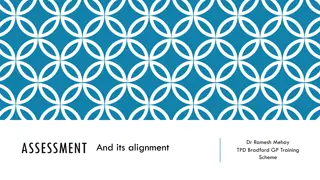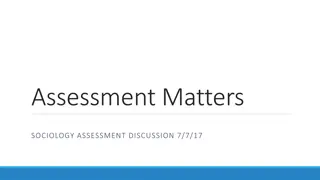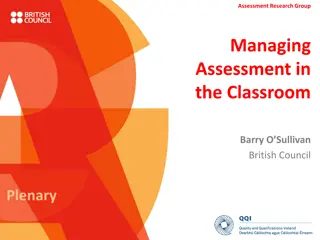Assessment of School Safe Zones Project & Implementation in Murang'a County, Kenya
The report assesses the efficacy of the School Safe Zones program in Murang'a County, Kenya, launched in 2003 to enhance safety in school environments. Data collected from sampled school heads showed high awareness and accessibility of the School Safety Manual. Findings revealed positive feedback on the clarity of topics covered in the manual. The assessment aimed to compare safety indicators between project and non-project schools in the region.
Download Presentation

Please find below an Image/Link to download the presentation.
The content on the website is provided AS IS for your information and personal use only. It may not be sold, licensed, or shared on other websites without obtaining consent from the author.If you encounter any issues during the download, it is possible that the publisher has removed the file from their server.
You are allowed to download the files provided on this website for personal or commercial use, subject to the condition that they are used lawfully. All files are the property of their respective owners.
The content on the website is provided AS IS for your information and personal use only. It may not be sold, licensed, or shared on other websites without obtaining consent from the author.
E N D
Presentation Transcript
An Assessment of the School Safe Zones Project and Implementation of the School Safety Manual in Murang a County-Kenya Prepared by George Khisa 10thFebruary, 2017
Introduction Introduction Church World Service (CWS) and Ministry of Education (MOE) in Kenya launched the School Safe Zones (SSZ) program in 2003, to enhance safety in school environments. The program was piloted in 10 primary schools; later expanding to 70 schools in five Counties. In 2008, MOE and CWS released a Safety Standards Manual for schools in Kenya. This is a report of an assessment of the efficacy of the SSZ program. Assessment covered Murang a East and Gatanga sub-counties of Murang a county.
Methodology Methodology The assessment was done at two levels: oFirst, data were collected from 29 purposively sampled school heads from both Murang a East and Gatanga sub-counties on their familiarity and use of the manual. oSecond was an assessment comparing select school safety indicators between six project schools and six non-project schools in Murang a East sub-county.
Key Findings Key Findings - - 1 1 Awareness and Accessibility of the SSZ Manual Level of awareness of School Safety Manual was high: oAwareness of the manual was high regardless of whether a school was in the SSZ project or not. oAlthough only 17 schools in Murang a county were in the project, 89% of the 29 school heads interviewed knew about the manual. oThis was due to spill over through peer-to-peer interactions & MOE work. Yes No Ever read the safety manual 21 7 School ever received a copy of the safety manual 22 7 Ever heard of safety standard manual 26 3 0 10 20 30 40 No. of School Heads Principals from other schools come for benchmarking to see how our school has improved (in aspects of safety) Principal, SSZ School, Murang a East.
Key Findings Key Findings - - 2 2 Accessibility of the School Safety Manual was high: o76% (22) school heads said they had received a copy of the manual. o The number of copies varied from school to school the lowest being one and highest 15. oOf the 22 who had received, 21 (95%) reported having read the manual and 10 of these had been trained on it by MOE. Number of Hard Copy SSZ Manuals Received per School 19 20 15 # of Schools 10 8 5 1 1 0 None 1-3 4-5 >5 # of SSZ Hard Copy Manuals
Average Rating of Clarity of SSZ Manual Components Key Findings Key Findings - - 3 3 school community relations 85% Disaster risk reduction 81% Most topics in the School Safety Manual were clearly conveyed by MOE: oThe highest topic was rated at 89 per cent level of clarity and the lowest at 78 per cent. oTeachers felt that MOE trained well on the manual but time for asking questions was inadequate. Transport safety 80% Safety against child abuse 84% safety of children with special 84% socio cultural environment of the school 78% Teaching and learning environment 89% safety against drug and substance abuse 84% food safety 79% Safety in school environment 86% Health and hygiene safety 89% Safety in infrastructure 88% safety on school ground 85% 70% 72% 74% 76% 78% 80% 82% 84% 86% 88% 90% Average rating of clarity of component
Key Findings Key Findings - - 4 4 Self-rating on the use of the SSZ Manual by School Heads Most schools had implemented the manual: oThe level of implementation varied. Schools in the SSZ project had implemented more components than comparison schools. 14 12 12 # of School Heads 10 7 8 6 4 1 2 0 0 o86% of school heads said they had a circular or policy on School Safety. oSchool heads rated their implementation at different levels but most rated themselves at 50%-75%. <25% 25%-49% 50-75% >75% Self-Rating I Have 17 schools that have been under SSZ program and can confirm that in those schools, implementation is very good. It is at 90% . MOE Official, Murang a East
Key Findings Key Findings 4 4 cont cont The safety measures implemented included oRemoval of metal grills from dormitory windows oCreation of additional doors oChanging doors and windows to open outwards. oFencing the school and installing gates oTraining the students on first aid oMaking provisions for students with disabilities oPlanting grass in the school compound to reduce dust and slippery grounds oFood and hygiene safety oInvolving students in cleaning and beautification exercises oIncreasing water sources among others
Key Findings Key Findings - - 5 5 SSZ schools performed better than comparison schools in most safety aspects o Dealing with disaster response o Life skills teaching and school fencing o Having hand washing stations and kitchens o Daily use of these hand washing stations by children SSZ schools also scored better in food security indicators: o 85% had a feeding program compared to 15% for comparison schools o 85% reported that parents contributed to the feeding program compared to 65% for comparison schools o Most SSZ schools had reliable water sources such as piped water while most comparison schools used less reliable sources (rain water). Average Score on Food Security 90% 83% 83% 80% 67% 70% 60% 50% 40% 30% 17% 20% 10% 0% Has feeding program Parents contribute to feeding program SSZ schools Comparison schools
Key Findings Key Findings 5 5 cont In a few aspects, SSZ schools and comparison school had similar scores. oThe two tied in dealing with child abuse oworking with children with special needs ocondition of classrooms and chairs oMaintenance and usage of toilets Comparison schools had lower pupil/toilet ratio than SSZ schools. They also had lower ratios in hand washing stations and boys drinking water stations. cont The school has moved from below average to above average performance, this is attributed to presence of water in the school compound as compared to before where they obtained water from the river that was dangerous, .Chair, BOM, Ndikwe.
Key Findings Key Findings - - 6 6 Ave KCPE Performance Trend 2012-2015 for SSZ and Comparison Schools Schools reported several positive changes in schools after implementing safety measures: Improved infrastructure and food security Enhanced parent/community support Better teacher-pupil relations Better pupil retention Less absenteeism Improved academic performance. Average KCPE mean score for SSZ schools was on an upward trend but for comparison schools was on a downward trend o Teachers: As a result, their schools were being used by MOE as role models from which other schools could learn. 260 250 240 KCPE Mean Score 230 SSZ Comparison 220 210 200 190 2012 2013 2014 2015 The school performance has improved since the initiation of the (SSZ) project Chairperson, BOM, Gakindu Primary School.
Key Findings Key Findings - - 7 7 Activities Carried Out in Last Two Years Community involvement was higher in SSZ schools than comparison schools: o Contribution of money, materials and labour o Working with local health facilities to provide services o BOM members from SSZ schools, who were interviewed demonstrated a high level of consciousness of school safety. In SSZ schools however, the frequency of parents meetings varied from school to school. o Some BOM members reported that parents met twice a term but others said the meetings were irregular and depended on need. 1.2 1.0 0.8 Ave score 0.6 0.4 0.2 0.0 community contributed money, materials or labour connection to health facility Deworming Health Inspection Presentations on health supplies SSZ School Comparison School There is a very big change (in parental ownership). Parental support towards education of the child has been occurring. They have supported meal programs and PTA initiatives like buying of school resources, BOM member, Mbiri.
SSZ Schools BOM Members' Consciousness of School Safety Aspects: Their Statements
Key Findings Key Findings - - 8 8 Grant Application Activities SSZ schools had mobilized more resources to support school safety than comparison schools: o A higher proportion of SSZ schools had a fundraising plan, knew how to apply for external funding; and had applied for funding o SSZ schools had conducted more SMC/BOM meetings to discuss grant applications, had initiated more grant applications and had more successful applications. The proportions of SSZ schools and comparison schools were comparable in four aspects including having strategic plans, plans on school safety, infrastructure maintenance, action plans, and priority lists. 4 3 Ave No. of Activities 2 1 - SMC BOM discussed fundraising grant Sucessful CDF Funds County govt meetings applications fund SSZ school Comparison school
Key Findings Key Findings 8 8 cont cont On average, SSZ schools had raised more funds than comparison schools Average Amount of Funds Raised Per School in the Past Year (Ksh) 350,000 312,500 Our priority for this year is to construct covered walkways. Our school is set on a hill and it is quite dangerous to walk downhill when it rains , BOM member, Mbiri. 300,000 Ave. Amount (Ksh) 250,000 193,333 200,000 150,000 100,000 50,000 - SSZ school Comparison school
Key Findings Key Findings - - 9 9 Implementation of safety measures was hindered by: oLack of finances oLow buy-in in some communities oInadequate number of trained teachers oInadequate time to focus on school safety oInadequate knowledge and skills on fundraising for school safety initiatives among BOM members.
Key Findings Key Findings - - 10 10 The School safety manual has a few gaps and needs to be better disseminated in schools: Implementation of the manual has been a challenge due to varying interpretations among the different implementers hence the need for sensitization and capacity building workshops MOE Official, Murang a. oInadequate information e.g. how to ensure security when metal grills have been removed from windows oInadequate time allocated for training oMOE officials corroborated these sentiments and said the level of understanding and implementation of the safety manual varied from school to school. They also said that dissemination of the manual needed to be strengthened.
Recommendations Recommendations - -1 1 The SSZ project had helped improve safety in schools using fairly sustainable approaches and should be scaled up to reach more schools Allocate more time for training on safety manual and for question and answer sessions Distribute safety manuals to schools that have none or redistribute the manuals in the schools so that all schools have a copy Identify and beef-up topics that are least clear Provide more school-level, one-on-one support Build the capacity of schools to mobilize resources to implement the manual Identify and publicly recognize model schools
Recommendations Recommendations - - 2 2 Facilitate exchange learning visits to model schools Strengthen community engagement aspects in the manual Build the capacity of other stakeholders, such as local administration to appreciate their role in school safety Explore using information communication and technology tools including social media, to facilitate discussions among teachers and between teachers and county-level Ministry of Education officials, in the implementation of the safety manual.






















